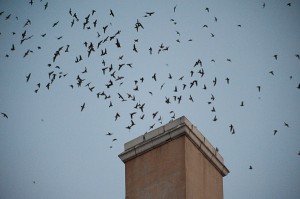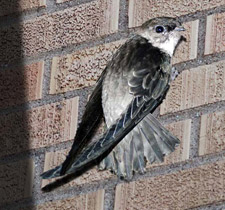Only in the asphalt jungles of downtown Los Angeles can one witness the powerful and mouth-dropping mysteries of nature from atop a simple parking structure. And we’re not talking the leery-peeping-Tom, things-you-don’t-want-your-grandma-or kids-to-even-KNOW-about brand of wildlife. No, we’re talking authentic feathers, beaks, talons and razor sharp bird brains. Real-time 3-D wildlife.
The flight of the petite but speedy Vaux’s swifts from Southern Alaska to their Central America winter home is just as astonishing as the great migration of the wildebeests across the Serengeti-Mara plains – perhaps not as thunderous and with, thankfully for the observer, no chance of being trampled underfoot.
No, the only real danger of watching these amazing flappers take their evening roost in a single chimney of the nearby Chester Williams Building is that where there’s 14,000 birds overhead in one concentrated place, there’s bound to be some, er, um, “avarian leakage” frosting the scenery. (Forcyringoutloud people, wear a hat when you come to see them.)
Jeff Chapman, director of the Audubon Center at Debs Parks, has been tracking the movement of the birds with his fellow Auddy buddies up and down the coast. Determining when the birds will hit Los Angeles is an unknown science, but he generally expects the birds to reach their peak from the mid to late September on their southbound migration. This year is no exception with the small, cigar-shaped birds with crescent wings currently filling the sky at dusk amid a backdrop of skyscrapers, roaring helicopters and spewing busses.
Perhaps there’s a twinge of jealousy when Chapman talks about when the swifts roost at more bucolic locales. There’s Chapman Elementary School in Portland which boasts a dedicated website, volunteer swift spotters, and grassy beds for bird watchers. “Here we have the city surrounding us,” he says noting that the urban grittiness only adds to the delight of seeing the thousands of birds circling overhead in a dance of pure instinct and primal drive. “We’re in nature all the time and sometimes we just don’t see it.”
Indeed, the spectacle gives pause to any causal non-bird watcher who unsuspectingly notices the kinetic cloud overhead. “Are those bats?” asks one parking lot patron who sees Chapman and a small group of birders sitting on folding chairs with heads cocked skyward and binoculars in hand. Chapman gives him the low-down. Twice a year, Vaux’s swifts pass through Los Angeles, but it’s only been two years ago they have been found using this spot for overnight housing. Chapman heard that folks used to see them use the abandoned old Nabisco Bakery near the Loft District, but that was years ago.
“There may be other places they roost in the city. We just don’t know,” he says adding that the next big roost for the swifts on their southbound journey is in downtown San Diego. “We know that they can make it from San Francisco to Los Angeles in one day.”
When not plunging into the chimney for the night where they will cling to the walls and keep each other warm, the swifts are extremely active eaters during the daylight. Vauxies have voracious appetite for small flying insects, beetles and bugs, as they gorge themselves to keep up their strength for their travels. For anyone who’s swatted a fly or cursed a mosquito, these birds are your pals.
It’s nice to know that the swiftly-flying swifts are not technically endangered, but there is concern that many of their favorite man-made roosting centers are disappearing. With many old masonry chimneys being torn down, the birds are without adequate cover for the night and safe from predators, like the ravens that perch on the chimney top, picking off a swiftie evening snack. The birdwatchers on the parking lot roof see the ravens nonchalantly capture swifts and fly away with their prey for solitary dining.
“This is probably why swifts lay many eggs, because it helps their numbers when they migrate,” explains Chapman.
Still, it’s not hard to feel sorry for the few Vauxies that are snatched away; it’s easy to raise a shaking fist at the opportunistic ravens. After all, those black birds haven’t flown hundreds of miles in a single day – they just laze around trash cans or scoop up fallen food here on downtown’s Broadway Avenue. What do they know about sacrifice and endurance?
As the sun finally disappears and blackness settles in, the birds pick up the pace as they enter their nightly lodging. Suddenly, they swirl in unison, a giant whirlpool of feathers flapping, accompanied by small tweets and then, swoop! Down the chimney they zoom and in a flash, the sky is suddenly empty of swifts.
“People pay big money to see the whales migrate up and down our coasts,” says Chapman. “Well, here is another migration that is as equally as impressive that everyone can witness – and it doesn’t cost much at all.”
We agree. We also think that the swifts need a better creative marketing manager. After all, their cousin the swallow has songs, traditions and parades built up around their annual migration. Musicians, now is your time. We challenge you to write that inspiring song that will tell this bird’s story. Get cracking. They are only here for a few more weeks.
The Audubon Center at Debs Parks and the Los Angeles Audubon Society will hold two organized public viewings of the Vaux’s swifts from 6 to 7:30 on Friday Sept. 23 and Sept. 30 atop Joe’s Auto Park at 440 Broadway in Downtown Los Angeles. Parking is $3. Birdwatchers are encouraged to bring picnics, binoculars and something to sit on, plus head covering. Park on level just below the top, because if you park your car on top, it will get “painted” by bird poo. We’re not kidding.
— Story by Brenda Rees; top photo credit Martha Benedict; center PAWS, bottom




Pingback: Downtown LA Viewing Tonight (9-16) | West Coast Swifts